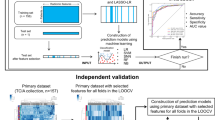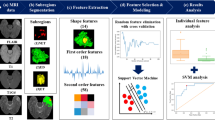Abstract
Accurate glioma classification before surgery is of the utmost important in clinical decision making and prognosis prediction. In this paper, we investigate the impact of multi-modal MR image fusion for the differentiation of low-grade gliomas (LGG) versus high-grade gliomas (HGG) via integrative analyses of radiomic features and machine learning approaches. A set of 80 histologically confirmed gliomas patients (40 HGG and 40 LGG) obtained from the MICCAI BraTS 2019 data were involved in this study. To achieve this work, we propose to combine T1 with T2 or FLAIR modality in the non-subsampled shearlet domain. Firstly, the pre-processed source MR images are decomposed into low-frequency (LF) and several high-frequency (HF) sub-images. LF sub-images are fused using the proposed weight local features fusion rule while HF sub-images are combined based on the novel sum-modified-laplacian technique. Experimental results demonstrate that the proposed fusion approach outperformed the recent state-of-the-art approaches in terms of entropy and feature mutual information. Subsequently, a key radiomics signature was retrieved by the least absolute shrinkage and selection operator regression algorithm. Five machine learning classifiers were established and evaluated with the retrieved dataset, then with the fused dataset using tenfold cross-validation scheme. As a result, the random forest had the highest accuracy of 96.5% with 21 features selected from the raw data and 96.1% with 16 features selected from the fused data. Finally, the experimental findings confirm that the proposed aided diagnosis framework represents a promising tool to aid radiologists in differentiating HGG and LGG.





source images. a DataSet-1, top: MRI, bottom: CT, b dataSet-2, top: MRI-T2, bottom: MRI-T1, c dataSet-3, top: MRI-T2, bottom: MRI-GAD, d dataSet-4, top: MRI-PD, bottom: CT





Similar content being viewed by others
References
Ostrom, Q., et al.: The epidemiology of glioma in adults: a “state of the science review. Neuro-oncology 16(7), 896–913 (2014)
Louis, D.N., et al.: The 2016 World Health Organization classification of tumors of the central nervous system: a summary. Acta Neuropathol. 131(6), 803–820 (2016)
Wesseling, P., Capper, D.: WHO 2016 classification of gliomas. Neuropathol. Appl. Neurobiol. 44(2), 139–150 (2018)
Aerts, H.J.W.L., et al.: Decoding tumour phenotype by noninvasive imaging using a quantitative radiomics approach. Nat Commun 5(1), 1–9 (2014)
Mohan, G., Monica, S.M.: MRI based medical image analysis: survey on brain tumor grade classification. Biomed. Signal Process. Control 39, 139–161 (2018)
Gillies, R.J., Kinahan, P.E., Hricak, H.: Radiomics: images are more than pictures, they are data. Radiology 278(2), 563–577 (2016)
Lambin, P., et al.: Radiomics: the bridge between medical imaging and personalized medicine. Nat. Rev. Clin. Oncol. 14(12), 749–762 (2017)
Bakas, S., et al.: Identifying the best machine learning algorithms for brain tumor segmentation, progression assessment, and overall survival prediction in the BRATS challenge. arXiv:1811.02629 (2018)
Zhou, M., et al.: Radiomics in brain tumor: image assessment, quantitative feature descriptors, and machine-learning approaches. Am. J. Neuroradiol. 39(2), 208–216 (2018)
Cho, H.-h, et al.: Classification of the glioma grading using radiomics analysis. PeerJ 6, e5982 (2018)
Lotan, E., et al.: State of the art: machine learning applications in glioma imaging. Am. J. Roentgenol. 212(1), 26–37 (2019)
Tian, Q., et al.: Radiomics strategy for glioma grading using texture features from multiparametric MRI. J. Mag. Resonan. Imaging 48(6), 1518–1528 (2018)
Vamvakas, A., et al.: Imaging biomarker analysis of advanced multiparametric MRI for glioma grading. Physica Med. 60, 188–198 (2019)
Du, J., et al.: An overview of multi-modal medical image fusion. Neurocomputing 215, 3–20 (2016)
James, A.P., Dasarathy, B.V.: Medical image fusion: a survey of the state of the art. Inf. Fusion 19, 4–19 (2014)
Li, S., et al.: Pixel-level image fusion: a survey of the state of the art. Inf. Fusion 33, 100–112 (2017)
Mahajan, S., Singh, A.: A comparative analysis of different image fusion techniques. IPASJ Int. J. Comput. Sci. (IIJCS) 2(1), 8–15 (2014)
Yin, M., et al.: A novel image fusion algorithm based on nonsubsampled shearlet transform. Optik 125(10), 2274–2282 (2014)
Wang, Z., Cuia, Z., Zhu, Y.: Multi-modal medical image fusion by Laplacian pyramid and adaptive sparse representation. Comput. Biol. Med. 123, 103823 (2020)
Liu, X., Mei, W., Huiqian, Du.: Structure tensor and nonsubsampled shearlet transform based algorithm for CT and MRI image fusion. Neurocomputing 235, 131–139 (2017)
Manchanda, M., Sharma, R.: An improved multimodal medical image fusion algorithm based on fuzzy transform. J. Vis. Commun. Image Represent. 51, 76–94 (2018)
Ouerghi, H., Mourali, O., Zagrouba, E.: Multimodal medical image fusion using modified PCNN based on linking strength estimation by MSVD transform. Int. J. Comput. Commun. Eng. 6(3), 201–211 (2017)
Ouerghi, H., Mourali, O., Zagrouba, E.: Non-subsampled shearlet transform based MRI and PET brain image fusion using simplified pulse coupled neural network and weight local features in YIQ colour space. IET Image Proc. 12(10), 1873–1880 (2018)
Yang, Z., et al.: An overview of PCNN model’s development and its application in image processing. Arch. Comput. Methods Eng. 26(2), 491–505 (2019)
Zhou, P., et al.: Side-scan sonar image fusion based on sum-modified laplacian energy filtering and improved dual-channel impulse neural network. Appl. Sci. 10(3), 1028 (2020)
Ullah, H., et al.: Multi-modality medical images fusion based on local-features fuzzy sets and novel sum-modified-Laplacian in non-subsampled shearlet transform domain. Biomed. Signal Process. Control 57, 101724 (2020)
Gore, S., Tanay, C,. Jayant, J., Ingalhalikar, M.: A review of radiomics and deep predictive modeling in glioma characterization. Acad. Radiol. (2020)
Wu, Y., Bo, L., Weiguo, W., et al.: Grading glioma by radiomics with feature selection based on mutual information. J. Ambient Intell. Human. Comput. 9, 1671–1682 (2018)
Qi, X.-X., et al.: Histogram analysis of diffusion kurtosis imaging derived maps may distinguish between low and high grade gliomas before surgery. Eur. Radiol. 28(4), 1748–1755 (2018)
Wang, Q., et al.: Radiomics nomogram building from multiparametric MRI to predict grade in patients with glioma: a cohort study. J. Mag. Reson. Imaging 49(3), 825–833 (2019)
Su, C., et al.: Radiomics based on multicontrast MRI can precisely differentiate among glioma subtypes and predict tumour-proliferative behaviour. Eur. Radiol. 29, 1986–1996 (2019)
Cao, H., et al.: A quantitative model based on clinically relevant MRI features differentiates lower grade gliomas and glioblastoma. Eur. Radiol. 30, 3073–3082 (2020)
Rathore, S., et al.: Glioma grading via analysis of digital pathology images using machine learning. Cancers 12(3), 578 (2020)
Brunese, L., et al.: An ensemble learning approach for brain cancer detection exploiting radiomic features. Comput. Methods Prog. Biomed. 185, 105134 (2020)
Saba, T., et al.: Brain tumor detection using fusion of hand crafted and deep learning features. Cognit. Syst. Res. 59, 221–230 (2020)
Sudre, C.H., et al.: Machine learning assisted DSC-MRI radiomics as a tool for glioma classification by grade and mutation status. BMC Med. Inf. Decis. Making 20(149), 1–14 (2020)
Menze, B.H., et al.: The multimodal brain tumor image segmentation benchmark (BRATS). IEEE Trans. Med. Imaging 34(10), 1993–2024 (2014)
Bakas, S., et al.: Advancing the cancer genome atlas glioma MRI collections with expert segmentation labels and radiomic features. Sci. Data 4, 170117 (2017)
Rohlfing, T., Zahr, N.M., Sullivan, E.V., Pfefferbaum, A.: The SRI24 multichannel atlas of normal adult human brain structure. Hum. Brain Map. 31(5), 798–819 (2010)
Zitova, B., Flusser, J.J.: Image registration methods: a survey. Image Vis. Comput. 21(11), 977–1000 (2003)
Easley, G., Demetrio, L., Lim, W.-Q.: Sparse directional image representations using the discrete shearlet transform. Appl. Comput. Harmonic Anal. 25(1), 25–46 (2008)
Van Griethuysen, J.J.M., et al.: Computational radiomics system to decode the radiographic phenotype. Cancer Res. 77(21), e104–e107 (2017)
Tibshirani, R.: Regression shrinkage and selection via the lasso. J. R. Stat. Soc. Ser. B (Methodology) 58(1), 267–288 (1996)
Hall, M., et al.: The WEKA data mining software: an update. ACM SIGKDD Explor. Newsl. 11(1), 10–18 (2009)
Mohammed, A., Nisha, K.L., Sathidevi, P.S.: A novel medical image fusion scheme employing sparse representation and dual PCNN in the NSCT domain. In: 2016 IEEE Region 10 Conference (TENCON). IEEE, pp. 2147–2151 (2016)
Liu, X., Mei, W., Huiqian, Du.: Multi-modality medical image fusion based on image decomposition framework and nonsubsampled shearlet transform. Biomed. Signal Process. Control 40, 343–350 (2018)
Jagalingam, P., Hegde, A.V.: A review of quality metrics for fused image. Aquat. Procedia 4, 133–142 (2015)
Haghighat, M.B.A., Aghagolzadeh, A., Seyedarabi, H.: A non-reference image fusion metric based on mutual information of image features. Comput. Electr. Eng. 37(5), 744–756 (2011)
Hu, J., et al.: Machine-learning-based computed tomography radiomic analysis for histologic subtype classification of thymic epithelial tumours. Eur. J. Radiol. 126, 108929 (2020)
Dogra, J., Jain, S., Sood, M.: Glioma extraction from MR images employing gradient based kernel selection graph cut technique. Vis. Comput. 36(5), 875–891 (2020)
Ali, H., Faisal, S., Chen, K., Rada, L.: Image selective segmentation model for multi-regions within the object of interest with application to medical disease. Vis. Comput. 1–17 (2020).
Xi, P., Guan, H., Shu, C., Borgeat, L., Goubran, R.: An integrated approach for medical abnormality detection using deep patch convolutional neural networks. Vis. Comput. 36, 1869–1882 (2020)
Singh, R., Aditya, G., Raghuvanshi, D.K.: Computer-aided diagnostic network for brain tumor classification employing modulated Gabor filter banks. Vis. Comput. 1–15 (2020).
Author information
Authors and Affiliations
Corresponding author
Rights and permissions
About this article
Cite this article
Ouerghi, H., Mourali, O. & Zagrouba, E. Glioma classification via MR images radiomics analysis. Vis Comput 38, 1427–1441 (2022). https://doi.org/10.1007/s00371-021-02077-7
Accepted:
Published:
Issue Date:
DOI: https://doi.org/10.1007/s00371-021-02077-7




